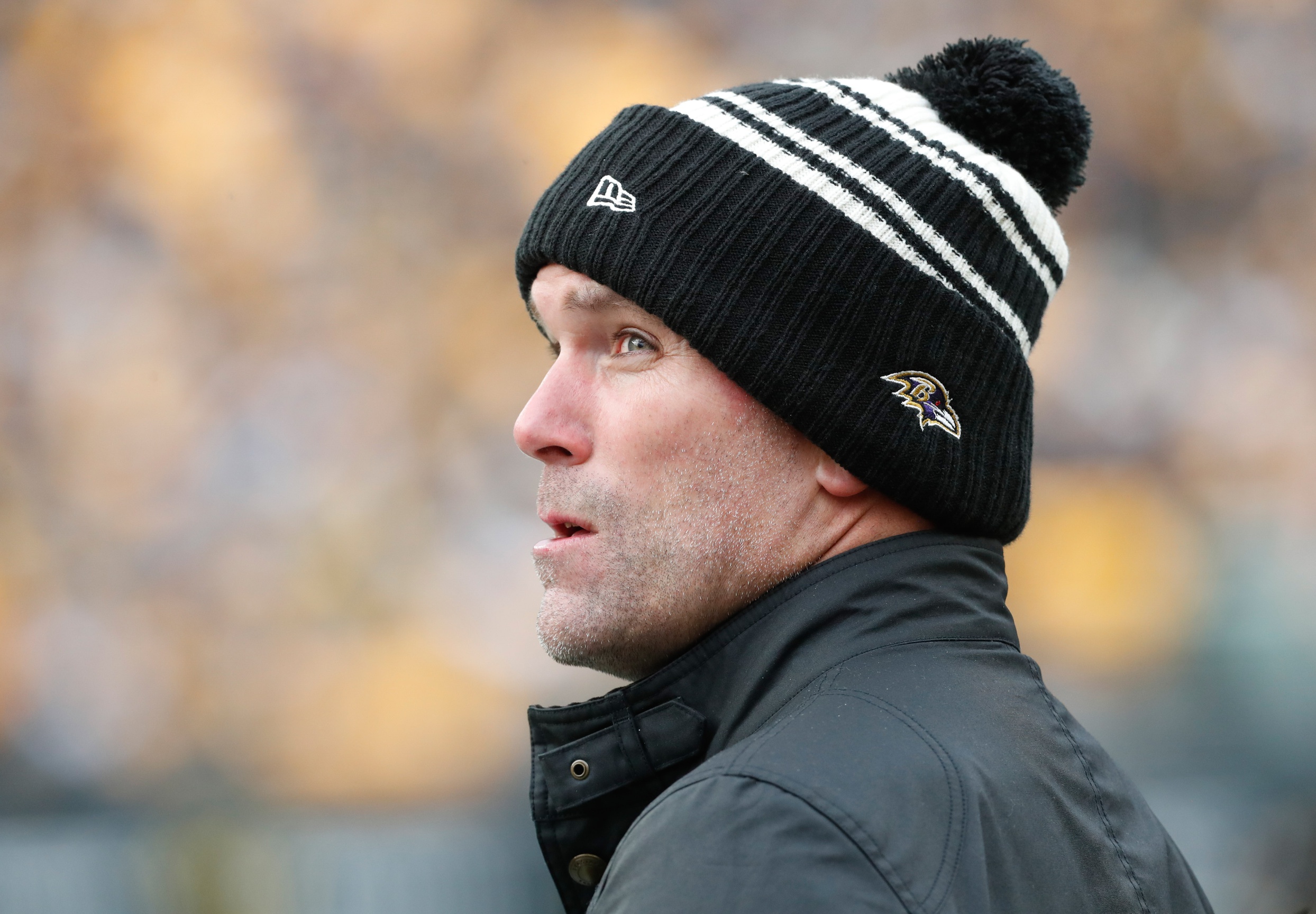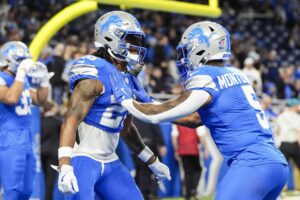The 2023 Baltimore Ravens contract situation is certainly an interesting one. How Eric DeCosta has prioritized Baltimore’s contracts for their starters was established in the first part of this miniseries.
[metabet_core_side_odds_tile query=”fbp/baltimore_ravens” size=”350×300″ site_id=”lastwordonsports”]
Courtesy of the analysis published by Last Word On Sport’s own Mike Kashuba, the differences between the Ravens contract priorities compared to the rest of the league was highlighted in part one.
In part two of this deep dive, the effectiveness and sustainability of Baltimore’s model will be examined.
Read more: 2023 Baltimore Ravens Contracts Analysis Part 1
2023 Baltimore Ravens Contracts: A Model for Success?
How has the 2023 Baltimore Ravens Contract Model Fared so far?
Whether the Ravens’ system works truly remains to be seen. If they win the Super Bowl in 2023, many around the league will look at Baltimore’s contract priorities and try to emulate their system. However, would that be purely reactionary?
In short, no. And for a multiplicity of reasons too.
Under their current contract model, the Ravens have found a lot of success. It is not just 2023 when Baltimore have been black sheep, they have been for a few years now. And, truthfully, they have maintained success.
But how? A few principles underpin Baltimore’s approach to contracts. Baltimore pay standout players and they also pay positions that suit their system. In maintaining both of these considerations, the team are able to maximise their cap in impactful and effective ways.
Spending Based on System
The lack of investment in wide receiver has been alarming. Has it held them back? Most certainly. However, it has allowed them to retain Mark Andrews.
Between 2019 and 2022, Andrews’ production has been equivalent to that of a low-end number one wide receiver. However, he has done that without being paid top wideout money. On a surface level, that seems to be a bargain.
Tight ends have also been more fundamental to Baltimore’s system. It is no surprise that Baltimore have preferred to draft and pay receiving tight ends due to their capacity to block as well as catch. In the Ravens’ run-heavy system, this makes most sense.
This also explains why Pat Ricard has been paid. Fullbacks suit Baltimore’s system. Their willingness to spend on Ricard is testament to that.
Two factors benefit the Ravens here. The Ravens run-heavy system places greater importance on non-premium positions such as running back, tight end and fullback. This naturally means that the Ravens can spend more in low-demand positions, giving them better return for their investment.
The second factor is that Baltimore have been careful in allocating cap to those positions that help improve their gameplan, especially on offense. That is why Baltimore have rarely spent big money on wide receivers. Spending extra on tight ends makes more sense for them.
Ravens largest per-yr average $ contracts given to WRs since Lamar Jackson became starter in 2019:
$15.0M – Odell Beckham Jr.
——–
$ 6.0M – Willie Snead
$ 5.0M – Sammy Watkins
$ 3.3M – Nelson Agholor
$ 3.1M – Rashod Bateman
$ 2.9M – Marquise Brown
$ 2.0M – Seth Roberts— Warren Sharp (@SharpFootball) April 9, 2023
Rewarding Talent in Non-Premium Positions
However, as mentioned, Baltimore are also keen to pay players that transcend their positional value. Hence their valuing of Roquan Smith and Justin Tucker. While most other NFL teams look at positional value in these instances, the Ravens buck the trend.
High end off-ball linebackers such as Devin White and Tremaine Edmunds have been devalued by their teams before. This is because the market dimply does not value that position. The Ravens, however, are more concerned with elite talent rather than positional value, it seems. While positional value is still important (hence their willingness to pay their quarterback, premier cornerback and left tackle), the Ravens also value elite talents in non-premium positions.
Should DeCosta opt to give J.K. Dobbins a big paycheck, this philosophy would be confirmed. Dobbins is a talented running back but as seen by Dalvin Cook and Saquon Barkley’s situations, running backs are seriously devalued.
In paying players that transcend their positional value, the Ravens get to maximise their cap by getting impactful players for less than the going rate.
Smith is an elite linebacker but, fundamentally, an elite defender who changes games. Tucker is one of the most clutch kickers in the league. This sort of talent wins games, even if they are not in consensus premium positions.
The philosophy boils down to two things: Baltimore remaining a run-heavy system and Baltimore (at times) ignoring consensus positional value in favour of talent.
Looking at Other Case Studies: Eric DeCosta is Unique but not Alone
The Kansas City Chiefs: Travis Kelce and the Wideout Committee
The Kansas City Chiefs have had a similar, if not more radical, approach to some of their contracts. Their unique similarity with Baltimore comes in how they have prioritised their receiving group.
Like Baltimore, Kansas City have not paid top wide receiver money. This was well documented in their Super Bowl victory this past season.
Instead of paying a premium wideout (namely, Tyreek Hill), Brett Veach constructed an adept committee of wideouts. In 2022, this included Marquez Valdes-Scantling, Skyy Moore, Juju Smith-Schuster, Kadarius Toney and a couple more.
This is because the Chiefs decided to keep Travis Kelce in the long run instead. Kelce, the league’s top tight end, has been Mahomes’ most reliable target. Their connection has a similar synergy to the one that Jackson has with Andrews. And, in Baltimore, it appears that the idea is to emulate the Chiefs in creating a diverse wideout committee around an elite tight end.
The San Francisco 49ers: George Kittle and Fred Warner
The San Francisco 49ers, meanwhile, are another team that have a comparable model. This is because they have a seemingly similar philosophy to the Ravens.
Like Kansas City and Baltimore, San Francisco value their tight end. That is why George Kittle is so handsomely paid ($15 million APY).
The 49ers also value their off-ball linebacker, Fred Warner, however. Warner is a key presence for San Francisco. While he may not offer the star factor that Nick Bosa has, he is an integral part of their system.
Although Smith is arguably a better player than Warner, the thinking is the same. Both are impact players, even if in non-premium positions.
The 49ers and Chiefs are two teams that have distinct similarities with the Ravens in terms of their contract priorities. Both teams have found a lot of success lately, more than the Ravens even.
There are, of course, other examples of contract rankings that are similar to the Ravens but have found less success. The Bill O’Brien-era Houston Texans come to mind. A more extreme example might be the current New England Patriots. But both these teams have some substantial differences to the Ravens philosophy too though.
Is the 2023 Baltimore Ravens Contract Model Sustainable?
Part of the sustainability questions have already been answered. Indeed, Baltimore have maintained their current contract model for the last few years. While it has not resulted in a Super Bowl victory, they have remained competitive.
However, is that a fallacious induction? The NFL is an ever-changing landscape and, just because something has worked before, does not mean it will work forever.
So, the question is this: will the 2023 Baltimore Ravens contract model remain successful in the future? The answer is complicated.
The Ravens’ Playstyle Influencing Contract Priorities?
The first part of this must consider whether the Ravens run-heavy offensive scheme is compatible for the future. This is because a large part of the Ravens contract priorities come down to prioritizing the run (hence the valuing of the tight end and fullback and the devaluing of receiver).
Although the league is moving away from run-heavy offenses, it is too radical to suggest that the Ravens’ smashmouth offense will be defunct in any way. Teams like the 49ers, Browns and Texans (among others), will likely continue to find enough success as run-heavy teams.
As such, even though Monken has been brought in to revolutionize the passing game, it is unlikely this will result in a total revolution of the Ravens contract priorities. They will still, for the foreseeable future, remain a run-first offense.
Even if the Ravens do move to a pass-heavy offense, a reformulation of their contract philosophy is still unnecessary. The Chiefs have shown that devaluing wideouts does not result in a decreased passing attack.
The Need for Transcendent Talents
The second consideration regarding the sustainability of Baltimore’s contract model examines whether paying transcendent talent is sustainable.
On a surface level, why not? It seems to make sense to continue to pay premium impactful talent. Especially considering that these talents are not in premium positions, meaning they will be cheaper than elite talents in premium positions.
However, it is hard to predict how sustainable this will be. Firstly, it relies on the heavy assumption that Baltimore will always be able to acquire or find talents like Smith, Tucker and Andrews. This is never a given.
Secondly, there could come a time where NFL teams make positional value more important. What if offenses become so pass-happy that inside linebackers are borderline useless? That might be an exaggeration, but the point stands. If the range of positional value continues to increase, it might be hard to justify spending top money on positions that no longer make much impact.
However, provided that players in non-premium positions continue to potentially impact football in game-changing ways, the Ravens contract model still makes sense.
It is also worth noting that the Ravens are not completely radical. While they may be black sheep when it comes to the positions they value and pay, they are still sheep after all.
Quarterback, cornerback and offensive line remain Baltimore’s bread and butter. Should Odafe Oweh and David Ojabo live up to their potential, Baltimore’s edge rushers are in for a nice payday too.
In this sense, Baltimore might be doing just enough to set themselves apart with a competitive advantage while also ensuring they do not fall out of the fundamental sound principles of contract prioritisation.
Main Photo: Charles LeClaire-USA TODAY Sports






